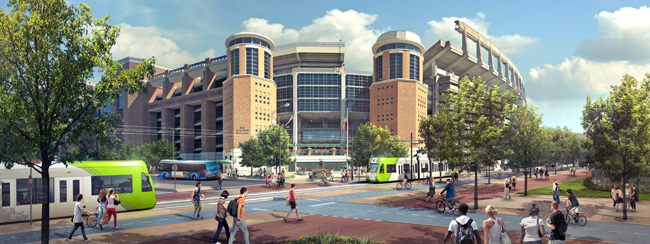Without a doubt, rail is a polarizing issue in Austin politics. On Tuesday, Student Government passed a resolution declaring support for Proposition 1, the Green Line urban rail and bond proposal. In July, given information and perspectives of the moment, this editorial board begrudgingly offered its endorsement for Project Connect’s urban rail plan. After further consideration and deliberation, it is only with sincere disappointment that this board must withhold our endorsement of Proposition 1, to be voted on this November.
While $600 million of the bond will go toward rail, $400 million of the bond is earmarked for road improvements. Perhaps an effort to shove a sub-par rail proposal down the public’s throat by enticing them with bundled road funds, the bundling of these two projects is unfortunate. Roads need improvement to alleviate traffic, and this disapproval of Proposition 1 should not be taken as disapproval of road improvement. Rather, the flaws of the urban rail plan outweigh the benefits of the linked road improvements.
There are two facts about public transportation that must be acknowledged before moving forward. First, the purpose of public mass transit, contrary to many pro-rail advertising campaigns, is not to ease congestion of personal vehicles. Public transportation provides an alternative to congestion, but it will never be the solution. Second, like public schools and municipal parks, public transportation is a necessary public service, not meant to be inherently profitable but sustainable enough to facilitate the everyday travel of a functioning community. With these two considerations, we must avoid auto-centric, capitalistic conversation regarding urban rail.
The route north of the river has caused the most controversy. While Project Connect, the plan’s creator, constantly touts the ‘data-driven’ plan, we question the metrics used in this designation. Project Connect used projected, as opposed to current, density data to drive its route proposal. Areas surrounding the Red Line have not seen this projected density growth that justified its creation, and we fear that, if passed, the Green Line will suffer a similar fate.
Capital Metro often references the “success” of the Red Line to boost confidence in voters that it can handle this new project. Though riders and Francine Pares, communications manager at Capital Metro, testify that at peak hours the Red Line is so full that there is standing room only, this is not a viable metric for measuring the real success of the line. Initial ridership projections of the Red Line estimated 3,000-4,000 riders per day growing to eventually 8,000-10,000 daily. In August, Pares said “more than 60,000 MetroRail trips are taken each month,” but keep in mind that a single person can make multiple trips in a day. This averages to around 2050 trips per day, less than initial estimates and nowhere close to projected growth. The fact that the Red Line has standing room only is a testament to the size of the vehicle rather than true demand. The “success” of the Red Line is dubious at best.
Furthermore, central corridor advocates overemphasized the risk of losing possible Federal Transit Administration funding, necessary for the current rail proposal, if they proposed a Lamar-Guadalupe route. They argue that because the city had just installed Bus Rapid Transit (BRT) using FTA funds on the same route, a request for funding on this route would be rejected. In addition to the explicit grant language containing provisions for future development funding along the BRT route disproving this claim, Scott Morris from Our Rail group provided a memo obtained from Capital Metro where an FTA representative is quoted saying the administration would consider funding for development along the BRT route should the city introduce new priorities.
With this new proposal, many look back nostalgically on the 2000 light rail proposal, thinking, “If only we had known!” This redesigned route of this current proposal is a reaction to the 2000 “rail fail,” attempting to the address issues that led a narrow margin of 2,000 more people to vote “no” at the turn of the century. But Austin has changed, and this proposal has not adequately adapted. More people than ever understand the need for comprehensive public transportation improvements. It’s a curious fact, and a daunting omen, that so many rail advocates have come out against this rail plan. Though we support transit initiatives that will make our city livable and affordable, we oppose this proposal.
















